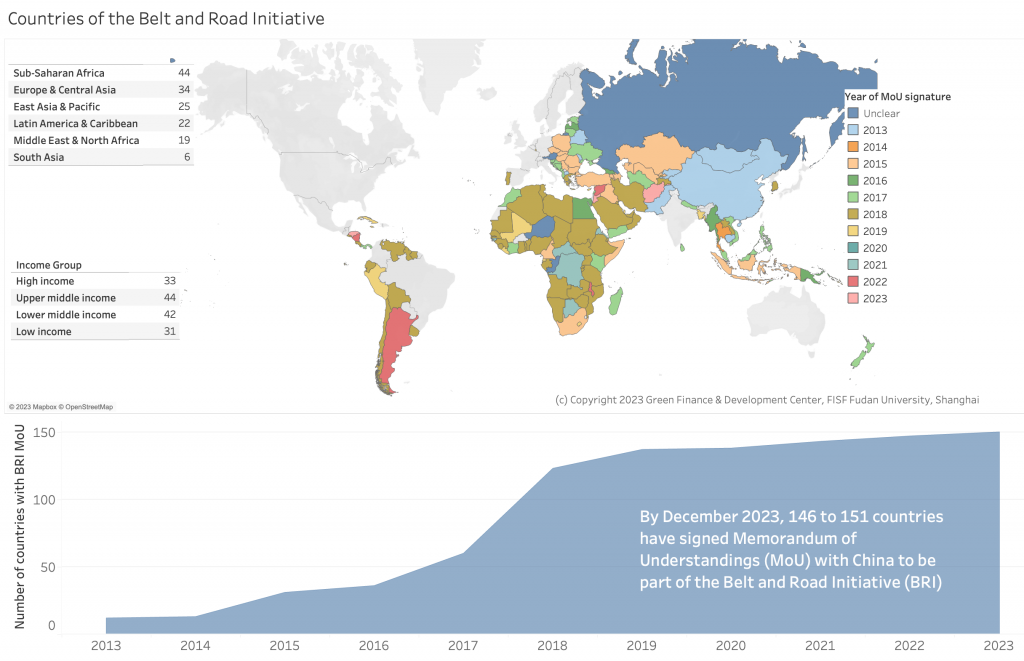What is the Belt and Road Initiative (BRI)?
The Belt and Road Initiative (BRI) is China’s main international cooperation and economic strategy. The BRI is also known as the “One Belt One Road” (OBOR), the “Silk Road Economic Belt and the 21st-century Maritime Silk Road” or just the “New Silk Road”. Its Chinese name is 一带一路 (yi dai yi lu). It was announced by Chinese President Xi Jinping in Kazakhstan in October 2013.
The construction of the Belt and Road Initiative is anchored in the Chinese constitution.
Learn more about
- Goals of the Belt and Road Initiative (BRI)
- Countries of the Belt and Road Initiative (BRI)
- Investments in the Belt and Road Initiative (BRI)
- Greening the Belt and Road Initiative (BRI)
- Governance of the Belt and Road Initiative (BRI)
Goals of the Belt and Road Initiative (BRI)

The BRI has officially “five goals”:
- policy coordination,
- facilities connectivity,
- unimpeded trade,
- financial integration, and
- people-to-people bonds.
Over the past years, the emphasis on developing a “green” and “high-quality” Belt and Road Initiative have accelerated. The Ministry of Environmental Protection (now Ministry of Ecology and Environment) had published the Guidance on Promoting Green Belt and Road already in 2017. The document stresses the relevance of the “ecological civilization”, “green development concepts”, “principles of resource efficiency and environmental friendliness” within the five goals (find more policy documents for the Belt and Road Initiative here).
Countries of the Belt and Road Initiative (BRI)
According to official information, in March 2022, 146 countries and 32 international organizations had signed cooperation agreements for the BRI. In order for countries and organizations to “join” the BRI, China and the respective country or organization sign a Memorandum of Understanding (MoU). There are a number of countries listed in official Chinese media (yidaiyilu.gov.cn), which did not confirm having signed a full MoU for cooperating under the Belt and Road Initiative framework. These include for example Russia, Austria, Congo D.R., Dominica, Niger, and Benin.
The following BRI map shows the list of countries that have signed MoUs or are said to be members of the BRI. The list only includes countries where signature of BRI MoUs have been publicly recorded in English news or on the official Chinese BRI government website www.yidaiyilu.gov.cn.
You can find a more detailed list of countries of the Belt and Road Initiative (BRI) here.

Financial engagement in the Belt and Road Initiative (BRI)
From 2013 to December 2021, China’s engagement in the BRI through construction contracts (often financed through Chinese financial institutions) and investments amounted to about USD 890 billion in countries of the Belt and Road Initiative (BRI).

For a more detailed and interactive overview of investments in the BRI, go here.
Greening the Belt and Road Initiative (BRI)
During the 2019 Belt and Road Forum, green and sustainable development of the Belt and Road Initiative took center stage, together with debt sustainability. Accordingly, the Ministry of Ecology and Environment initiated the BRI International Green Development Coalition (BRIGC) . With its 10 working groups, the BRIGC aims to support green development, e.g. in regards to
- green finance
- green transport
- green innovation
- green urbanization
- green standards
Several formal institutions have become relevant to green the Belt and Road Initiative, particularly through finance. Among the most prominent are the
- Belt and Road Initiative International Green Development Coalition (BRIGC), which is administered by FECO of the Chinese Ministry of Ecology and Environment (MEE). The BRIGC is an open platform with Chinese and international organizations as members established in 2019. It provides relevant policy studies and supports capacity building. Find more information on the BRIGC here.
- Green Investment Principles (GIP) for the Belt and Road Initiative introduced by the Green Finance Committee of China (GFC) and the City of London in 2018. Financial institutions and other organizations can sign up to the GIP, which consist of 7 principles. Find out more on the GIP here.
- China Council for International Cooperation on Environment and Development (CCICED). The CCICED is administered by the Ministry of Ecology and Environment (MEE) and provides recommendations through special policy studies (SPS) to the State Council. Its Chinese and international members and researchers are appointed. The SPS focus on various aspects of environment and development. For the past several cycles, green BRI had been one of the topics. Find more information here.
Governance of the Belt and Road Initiative (BRI)
Compared to other global initiatives (e.g. G20), the BRI currently does not have formal governance principles, nor a secretariat. In 2014, The Leading Group for Advancing the Development of One Belt One Road was announced. However little information has so far been available on this. On the other hand, many institutions have been employed or have emerged to contribute to the goals of the BRI, e.g.
- Chinese financial institutions, such as Silk Road Fund, China Development Bank, China Exim Bank,
- Multilateral financial institutions, such as the Asian Infrastructure and Investment Bank (AIIB) and the New Development Bank (NDB),
- Commercial banks, such as the Industrial and Commercial Bank of China (ICBC), China Construction Bank, or the Agricultural Bank fo China,
- Chinese regulators, such as the State Council that oversees all ministries and special commissions in China and establishes the overall blueprint for overseas investments (ODI) from China, or the China Banking and Insurance Regulatory Commission (CBIRC) that approves ODI projects by Chinese banks and oversees China’s insurance industry.,
- Chinese central bank – the People’s Bank of China (PBoC), which establishes monetary policy and manages foreign exchange reserves,
- Chinese ministries, such as the Ministry of Commerce (MOFCOM), which approves certain OFDI projects; the National Development and Reform Commission (NDRC), which develops OFDI goals and policies; the Ministry of Foreign Affairs (MFA) that administers China’s diplomatic relations and policies; the Ministry of Ecology and Environment (MEE) that co-issues environmental guidelines.
A more detailed overview was provided by Tufts University:
